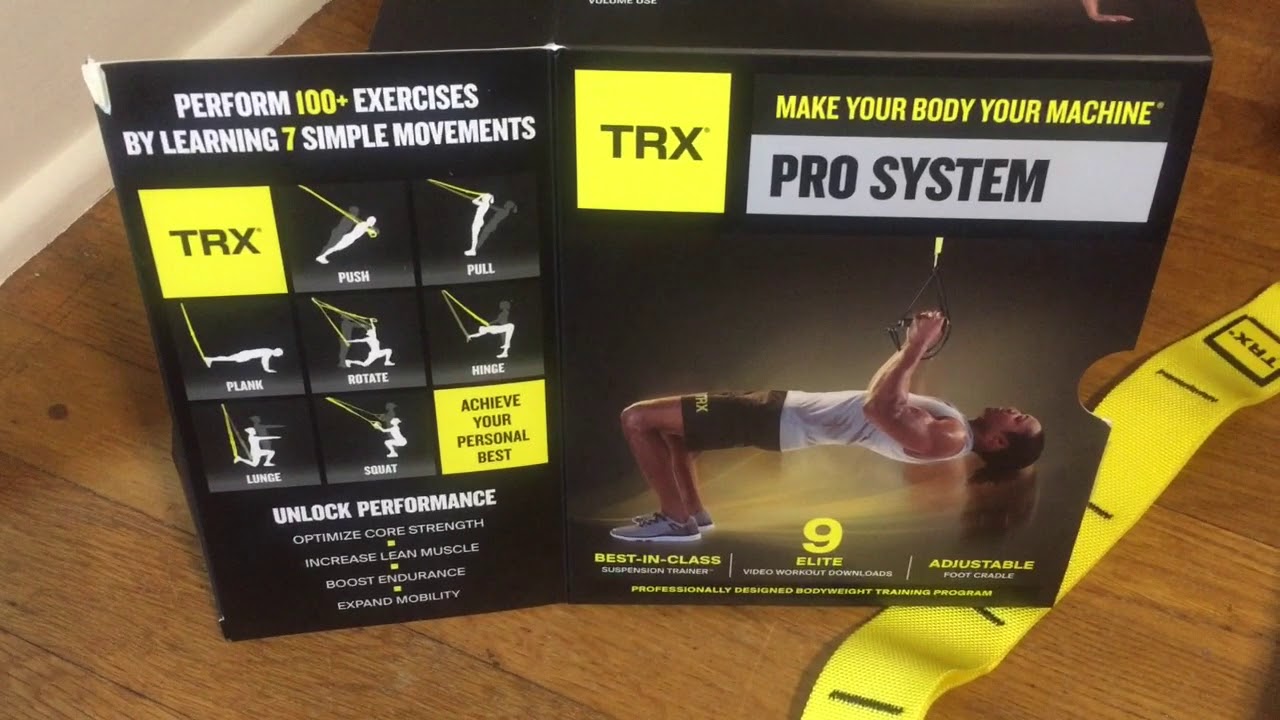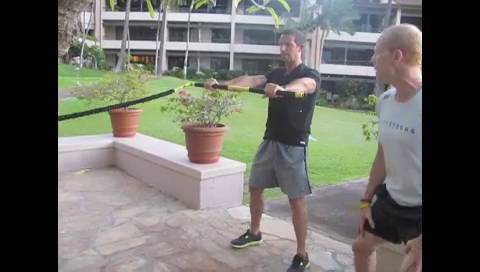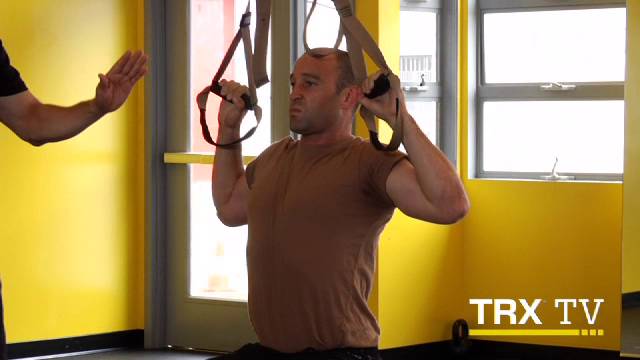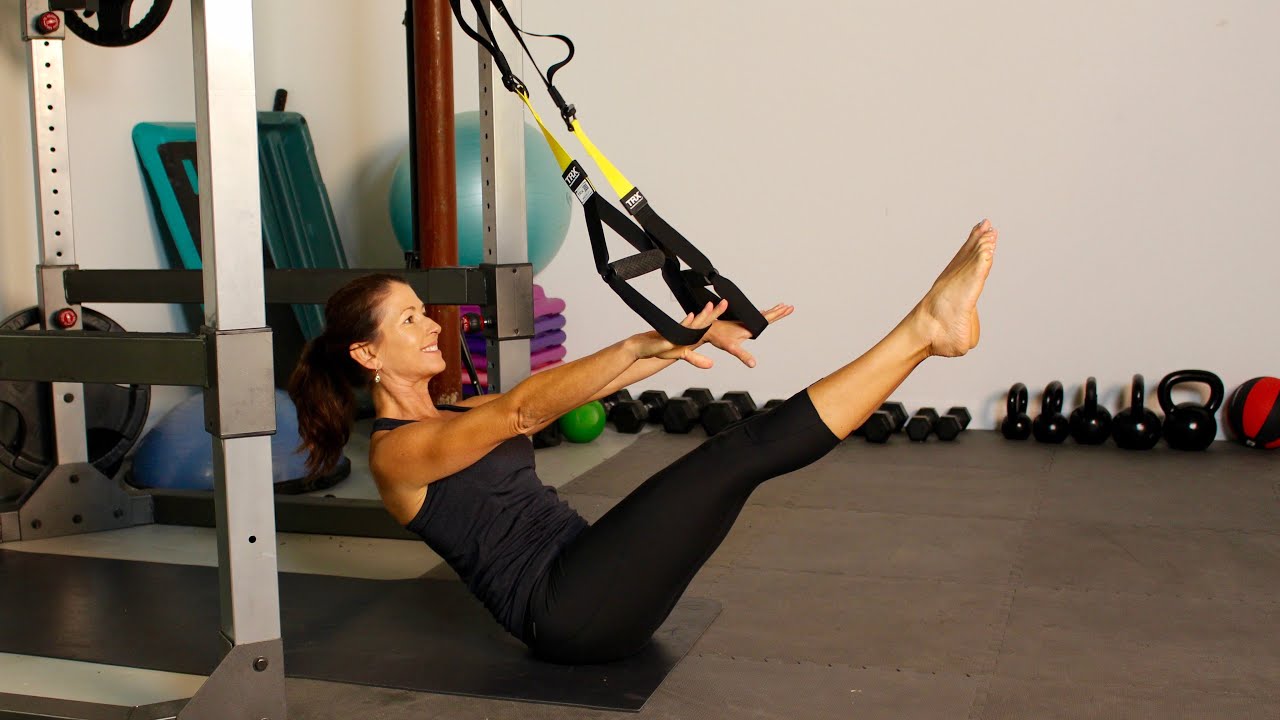News

TRX Rip Trainer: The Unboxing
While we try to put out a solid stream of useful content about Rip Training exercises, we also get a fair number of questions from the curious ones that fall into the "how-to" category. How do you anchor it? What comes in the kit? How diverse are the exercises? What kind of programming do you get?
TRX Director of Rip Training Pete Holman just put together this quick video to cover some of those questions for you.
Created by a two-time US National Taekwon do champion, the TRX Rip Trainer uses the asymmetrical loading of the resistance cord to constantly challenge one’s balance and force maximal muscle recruitment. Like the Suspension Trainer, the Rip Trainer is lightweight (~4lbs), portable, easy to setup and versatile, and it allows anyone at any level to get a full body workout. However, while the TRX Suspension Trainer is a static stability and strength device, the TRX Rip Trainer is a dynamic explosive power and metabolic device emphasizing rotational movements.
Stop by our store to see what other pro trainers are saying about TRX Rip Training and to learn more about the TRX Rip Trainer Kit. Please let us know if you have any specific questions so that we can address them.

TRX Rip Fusion Workout
Here’s an awesome TRX Suspension Trainer and Rip Trainer fusion workout from the beautiful island of Maui, with TRX Group Programming and Development Manager Dan McDonogh and TRX Master Trainer Alexandre Veret from France. These four exercises are ideal for activating your abs, lower back, shoulders and legs, or as McDonogh points out the anterior and posterior core, to develop 360-degree strength and stability.
Something to note, when we use the term “anterior core,” we are referring to the abdominal muscles that make up the front side of the body. When we use the term “posterior core,” we are referring to the glutes, lower back and middle back. Because the majority of these exercises have some sort of asymmetrical loading, they force you to engage your obliques and lats as well as your anterior and posterior core in order to resist going into rotation. The takeaway: this sequence has a huge return on investment for a total body workout.
The Sequence:
TRX Single Arm Hip Hinge
Rip Squat with I Deltoid Raise
Rip Reverse Lunge with a Pullover
TRX Overhead Back Extension
Perform each of these four exercises for five to seven reps per side (that means you are going to do eight sets total). Finish both sides of each exercise before moving on to the next.
Want more? Check out Part 2 of this series here.
Get your TRX Suspension Trainer here and your TRX Rip Trainer here.

TRX Recovery Workout
FROM THE VAULT: Statistics say you'll catch two to four colds per winter, regardless of rigorous application of hand sanitizer and avoidance of sick coworkers. We know your workouts are important to you, but during a cold, can exercise actually further compromise an already stressed immune system—or help it?
A 2001 study conducted by Albert Moraska and Monika Fleshner and published in the The American Journal of Physiology found that the intensity of exercise can either enhance or suppress immune function. Considerable research shows that during moderate exercise, several positive changes occur in the immune system, whereas strenuous or lengthy exercise sessions are followed by an impairment of the immune system.
Your best bet is to do a “neck check.” If your symptoms are located above the neck (e.g. stuffy nose and a sore throat), exercise at a moderate intensity is likely safe and possibly even beneficial. However, if there are “below-the-neck” symptoms such as a vomiting or diarrhea and if you have a fever, allow yourself to rest.
One of the many fantastic benefits of the TRX is its ability to adapt to any level of strenuousness. So if you feel a cold coming on, or if everybody in your house is coughing, give this easily regressable TRX workout a try, which may save you the misery of three weeks of a cold. Not sure about your ideal exercise intensity? Take our quick fitness quiz to get customized workout recommendations that match your current energy levels and goals. Perform 45 seconds of each exercise. (NOTE: The video is a bit longer than usual, but we felt it was important to address each of the foundational movements and offer tips on how to regress them. Times have been provided for ease of viewing.)
TAKE OUR TRAINING QUIZ
1. TRX Assisted Squat (1:12)
Regression: Use the TRX more for assistance throughout the full range of motion.
2.TRX Chest Press (1:47)Regression: Walk your feet forward to decrease your angle.
3.TRX Single Arm Row (2:30)Regression: Walk your feet back to decrease your angle.
4. TRX Assisted Side Lunge (3:14)Regression: Start with your feet apart and use the TRX for assistance throughout the full range of motion.
5. TRX I/T Shoulder Combo (3:56)Regression: Take a longer offset foot stance and move both feet back to decrease your angle.
6. TRX Torso Rotation (4:44)Regression: Walk your feet back to decrease your angle and rotate arms up at a higher angle.
7. TRX Hamstring Curl (5:29)Regression: Slide forward so your feet are in front of the anchor point and gravity will assist you through the full range of motion.
8. TRX Assisted Knee Raises (6:30)Regression: A greater knee bend will reduce the force through the range of motion.
These exercise regressions can be used for not just those feeling under the weather but many individuals from TRX newbies to the deconditioned to seniors... anyone who needs to scale back the intensity but not sacrifice results.
Shana Martin (www.shanamartin.com) is a TRX Senior Instructor, fitness expert, world champion lumberjack athlete, national spokesperson, fitness competitor, gymnast, pole vaulter, runner... the list goes on! Shana graduated from the University of Wisconsin with a degree in Kinesiology – Exercise Science. She is the current fitness director at Supreme Health and Fitness in Madison, and also does personal training and teaches group exercise. Shana was introduced to the TRX Suspension Trainer at the Club Industry Fitness Convention in Chicago after winning the TRX Atomic Push-up Challenge. Since then she has been using the TRX every day with every client. She also credits her sports success and fast rehabilitation after reconstructive knee surgery to the TRX.

TRX
TRX Pull Up
TRX Training
Watch this video to learn how to perform a TRX Pull Up. And for a truly customized training plan that matches your current strength level, take our quick fitness assessment quiz - it'll help you build the perfect workout progression. Pair this with our other TRX exercises for a well-rounded workout.
TAKE OUR TRAINING QUIZ
Here's the gear you can use to do a TRX Pull Up today (plus more with the Ybell and Strength Bands):
TRX® PRO4 SYSTEM
BUY NOW
TRX® HOME2 SYSTEM
BUY NOW
TRX® TACTICAL GYM
BUY NOW
You can also combine the TRX pull-up with other TRX exercises for a more effective full-body workout. For inspiration, try one of our classes at TRX Training Club:

TRX Power Pull
The TRX Power Pull presents unilateral back strength demands coupled with rotational strength and control, shown here with Fraser Quelch and TRX founder and CEO Randy Hetrick.
TAKE OUR TRAINING QUIZ

TRX Plank Progression Exercises
If you are bored just hanging there, try these moves out to intensify your core workout. It is a rare occasion when TRX Director of Programming and Education Fraser Quelch is out of breath. Well, just demonstrating this TRX Plank progression leaves him gasping for air!

TRX Pilates Workout
In this video, we've enlisted the help of Kirsten Gerding, a certified Pilates Instructor and TRX Trainer, to show us the following three Pilates-based moves you can perform on your TRX. Want to find the perfect Pilates-inspired TRX exercises for your level? Take our quick assessment quiz to get a customized workout plan that blends these two effective training methods.
TAKE OUR TRAINING QUIZ
TRX Stroking the Globe
Benefits: Activates abdominals and core stabilizer muscles, improves shoulder joint mobility
Adjust your TRX to the fully shortened position, stand facing away from the anchor point, your body centered with the anchor point, arms extended across from your chest, feet externally rotated, core engaged.
To perform the movement, roll your body forward, keeping your arms straight, creating full extension from your toes to finger tips, planking your entire body. As you start to roll yourself back to the start position, open your arms wide in a clockwise circular motion, keeping your arms straight and then bring your arms back together to the start position.
Repeat the exercise for six reps, and then reverse the arm movement to counter clockwise for another six reps.
TRX Hundreds
Benefits: Strengthens core muscles, improves breathing and coordination
Adjust your TRX to the fully lengthened position, lie on the ground face up, with your hips directly under the anchor point, hands in the foot cradles, extend yours arms straight towards your feet. Bring your legs into a table top position, with knees over hips, bent at a 90 degree angle, ensuring your back is flat against the ground.
Inhale, nod your head forward, pressing down into the handles, bringing yourself into an upper ab curl. Inhale as you press your hands down and out for a count of three, and exhale back in for a count of three to the start position, maintaining the upper ab curl the entire time.
To regress the exercise, place both feet on the ground; to progress, extend legs straight up. Perform the exercise for 10 reps.
TRX Swan Series
Benefits: Strengthens abdominals, back, glute and hamstring muscles
With your TRX still fully lengthened, lie on the ground facing away from the anchor point, arms extended out from the shoulders and reaching overhead. Keep your shoulders down and back.
With feet turned out, hips anchored to the ground, press down into the handles, lifting your chest off the ground by using your lower back muscles. Repeat the extension 10 times, keeping the core tight and hips down.
Continue the series by adding arm circle or "butterflies," by pressing your chest off the ground, driving the arms out and around. Repeat 10 times and then reverse the direction of your arm circles.
Complete the series by adding small flutter kicks or "swimmers," keeping your hips down and chest lifted as you engage your glutes throughout the movement.
To finish, lower your legs and chest down and release the TRX, pressing yourself back into Child's Pose.
In Pilates, it's important to focus on your breathing, so as you watch the video again, be sure to listen to Kirsten's cues for breathing technique as it will help you to further maximize the benefit of these exercises.
Need to limber up? Look no further than our TRX Essentials: Flexibility DVD, for desk jockeys and extreme sportsmen alike.

TRX Pilates
Pilates exercise is great for building kinesthetic awareness and teaching basic movement patterns. When teaching Pilates, TRX Senior Instructor PJ O'Clair likes to add the TRX Suspension Trainer to create a dynamic workout that mimics the demands of life and sport. "My clients have tried all of these exercises," says PJ. "I combine them with the traditional repertoire, and we have fun! Some of my clients have no idea they are doing Pilates until I tell them. They love the diversity, creativity and of course the results."
The following TRX Pilates exercises are perfect for clients of all levels.
TRX Shoulder Bridge Benefits: Activates posterior chain, improves lower kinetic chain mobility, and because this exercise is performed unilaterally, there is an increased challenge to avoid rotation of the pelvis which is ideal for strengthening the core stabilizers
Adjust your Suspension Trainer to mid calf position and configure into single handle mode. Lie on the ground facing the anchor point and place one heel in the foot cradles and the other flat on the ground with both knees bent. The suspended foot is directly under the anchor, arms long by sides.
Phase 1 - Inhale and press firmly into the suspended foot. Exhale and engage the glutes and hamstrings and lift the hips off the ground and then lower back to the start position. Repeat five times.
Phase 2 - Inhale and press firmly into the suspended foot. Exhale and engage the glutes and hamstrings and lift the hips off the ground. Inhale and hold the hips in the extended position. Exhale and lift the ground leg to the table top position, not allowing the pelvis to drop or rotate. Repeat five times.
Phase 3 - Inhale and press firmly into the suspended foot. Exhale and engage the glutes and hamstrings and lift the hips off the ground. Hold the hips in the extended position, inhale and bend and extend the ground leg through table top position to the fully extended position, holding the leg directly above the hip. Exhale and lower the leg straight down toward the opposite knee, only going as low as you can go without dropping or rotating the pelvis. Repeat the lowering and lifting phase three times and return back to start position. Repeat each set of three two times.
TRX Control Balance into Teaser Benefits: Strengthens core musculature, increases spine and hip mobility, activates the entire posterior chain, improves endurance of the core, breathing and coordination
Adjust your TRX to the mid calf position. Lie on the ground facing the anchor point, with your forehead directly under the anchor point. Hands are in the foot cradles with arms extended out by the hips. Bring both legs straight up to 90 degrees, directly over hips. Activate the abs to slightly imprint the pelvis so the spine is supported in the open chain position.
Phase 1 - Inhale and press down into the cradles. Exhale and roll the spine off the floor, bringing the legs overhead. Inhale to start, rolling back down. Exhale to return to the start position. Repeat three times.
Phase 2 - Inhale and press down into the cradles. Roll the spine off the floor, bringing the legs overhead. Exhale and reach the legs up toward the ceiling, extending the hips into the jackknife position. Inhale and stay in the extended position. Exhale an d scissor the legs, maintaining the shape. Breath normally while performing the scissoring action in and out. Repeat the scissors four times, alternating the legs and then roll back to the start position.
Phase 3 - Inhale to lower legs away from the body to approximately a 45 degree angle. Exhale to articulate the spine to roll up to the V position. Inhale and start rolling back down again. Exhale to return to the start position. Combine this movement with Phase 2 and repeat three to five times.
TRX Magician Leg Series Benefits: Strengthens spine and hip extensors, promotes ankle, knee and hip mobility, gives the sense of traction to the spine
With your TRX in the mid calf position, lie on the ground facing the anchor point. Both heels are in the foot cradles. Slide the body away from the anchor so the feet are on the down slop side of the Pendulum Principle. Lift hips up, extending t he hips and bringing the body in one long line, resting on the shoulders with the thoracic spine flexed, arms resting long by sides.
Phase 1 - Inhale to prepare, exhale to swing body in pendulum fashion, side to side first with the legs adducted. To increase the challenge to the core stabilizers, swing the legs with them abducted. Keep a normal breathing pattern throughout the movement, inhaling and exhaling as legs move through space. Repeat three to five times.
Phase 2 - When swinging the legs to each side, do a hamstring curl, flexing the knee of the same side leg, bringing it in toward the shoulder. Maintain core stability throughout the pattern without dropping the hips, laterally flexing the spine or sawing. Repeat five to 10 times in each direction and then roll back down.
Want more TRX Pilates workout ideas? Download TRX Essentials: Flexibility here.
PJ O’Clair is the owner of Clubxcel & Northeast Pilates, one of the largest STOTT PILATES Licensed Training Centers in the US. In addition to her work as a program developer and Master Instructor Trainer for STOTT PILATES, she is a TRX Senior Instructor, a published author and the recipient of the 2008 IDEA “Program Director of the Year” award.

TRX Partner Workout Ideas
In the video below, Doug Balzarini from Fitness Quest 10 in San Diego has taken some traditional exercises on the TRX Suspension Trainer and modified them to be done with a partner, for an intense workout that’s equal parts fun and effective. So if you or your friend or partner frequently find yourselves fighting over one TRX, we’ve got a compromise for you: TRX partner drills.
Research shows you are more likely to stick to a fitness program if you have someone motivating you and relying on you. And partner workouts provide a great social experience as well, which is perfect for people with busy schedules... and it's healthier than happy hour. Before starting your partner journey, take our quick compatibility quiz to get customized workout recommendations that match both you and your workout buddy's fitness goals.
TAKE OUR TRAINING QUIZ
1. TRX Burpee (with Knee Drive )With one foot suspended in the TRX foot cradles, Partner A performs a TRX Burpee while Partner B stands in front of her. After getting up off the ground, Partner A grabs the shoulder or behind the head of Partner B while driving her knee up and into a target (either hands or mitts).
2. TRX Elevated Row (with Hip Adduction)“Performing traditional TRX Rows with your feet elevated makes the exercise more challenging due to gravity,” says Doug. “Now, we’ve taken it a step further by involving the lower body more.” Partner A begins by lying on the ground directly under the TRX anchor point. In the first progression, Partner B holds Partner A's feet as he performs TRX Rows. If you want to make the exercise more challenging, Partner A can secure his feet and ankles around the hips of Partner B; this works to engage the hip adductors during the movement. This exercise is also a challenge for Partner B who must work to stabilize through the core. “A couple sets of these, and your inner thighs will be talking to you for sure,” says Doug.
3. TRX Plank (with Perturbations)Partner A gets into a TRX Plank position with while engaging the abdominals and maintaining a neutral spine. Partner B then gently pushes and pulls Partner A’s feet to challenge her balance and stability. This exercise will engage the shoulder stabilizers, abdominals, erectors in the posterior chain and even the quads and glutes. “I like to refer to the core muscles as ‘anti-movement muscles,’” says Doug. “By adding these small pushes and pulls to your partner’s feet, they really need to fight you in order to stay in a solid, strong position.”
4. TRX Burpee RaceFor this exercise, Doug recommends pairing up individuals who are relatively the same size. Both partners will have one foot in one of the TRX foot cradles and perform a set number of TRX Burpees as fast as possible. The partner who achieves the target number of reps first, wins. (NOTE: Do not allow the TRX to saw during this exercise.) This drill is sure to become a new favorite, especially among your more competitive friends or clients!
Do you use the TRX with a friend, or have you trained two clients on it at once? Tell us about it below.
Doug Balzarini works at Fitness Quest 10 (www.fq10.com) as a personal trainer, strength coach and Operations Director for Todd Durkin. A Massachusetts native, he earned his Bachelor’s degree in Exercise Science with a minor in Business Management from Westfield State College. Since moving to San Diego, he has completed some graduate work in Biomechanics at SDSU, obtained an ACE Personal Trainer certification, the NSCA-CSCS certification, a Spinning certification, TRX instructor training, EFI Gravity instructor training and FMS training. He has also appeared in eight fitness videos, written numerous fitness articles, completed a MMA Conditioning Coach certification program and has competed in multiple grappling tournaments.
